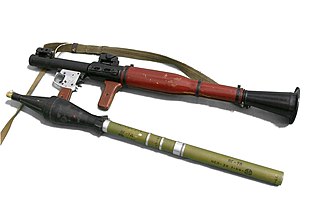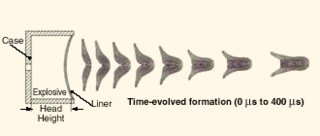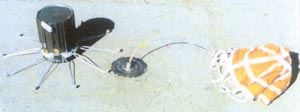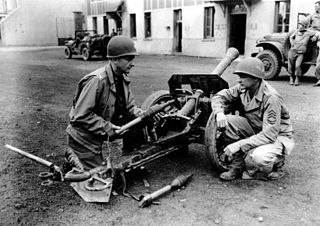External links
Mines of Nazi Germany during World War II | |
|---|---|
| Anti-tank | |
| Anti-personnel | |
The Hohl-Sprung Mine 4672 or Hohlladungs-Spring-Mine 4672 (HL.Sp.Mi. 4672) ("hollow-charge jump mine") was a German anti-tank mine, together with the Panzer stab 43. Developed during the Second World War it was the first landmine to combine a shaped charge anti-tank warhead with a tilt rod fuze.
The Panzerfaust warhead was mounted in a metal holder on a wooden panel buried in the ground with a Ki.Z.43 fuze protruding above the ground. When a vehicle passes over the mine, the rod is forced sideways triggering a black powder charge at the base of the projectile, launching the projectile out of the ground and into the belly of the vehicles.
The large shaped charge was capable of penetrating over 100 mm of belly armour, significantly more than tanks of the era had. Tests conducted by the Germans suggested the mine was capable of completely destroying (rather than merely disabling) 85% of the tanks it attacked, making it impossible to redeploy repaired vehicles and crew.
Deliveries to the Wehrmacht began in October 1944 but the mine was not issued to combat troops until January 1945 due to manufacturing faults. Only 59,000 were built because it was felt that the warheads were better employed with the proven Panzerfaust technology.

A rocket-propelled grenade (RPG) is a shoulder-fired missile weapon that launches rockets equipped with an explosive warhead. Most RPGs can be carried by an individual soldier, and are frequently used as anti-tank weapons. These warheads are affixed to a rocket motor which propels the RPG towards the target and they are stabilized in flight with fins. Some types of RPG are reloadable with new rocket-propelled grenades, while others are single-use. RPGs are generally loaded from the front.

Armour-piercing ammunition (AP) is a type of projectile designed to penetrate either body armour or vehicle armour.

High-explosive anti-tank (HEAT) is the effect of a shaped charge explosive that uses the Munroe effect to penetrate heavy armor. The warhead functions by having an explosive charge collapse a metal liner inside the warhead into a high-velocity shaped charge jet; this is capable of penetrating armor steel to a depth of seven or more times the diameter of the charge. The shaped charge jet effect is purely kinetic in nature; the round has no explosive or incendiary effect on the target.

The Panzerfaust was a development family of single-shot man-portable anti-tank systems developed by Nazi Germany during World War II. The weapons were the first single-use light anti-tank weapons based on a pre-loaded disposable launch tube, a weapon configuration which is still used today.

R4M, abbreviation for Rakete, 4 kilogramm, Minenkopf, also known by the nickname Orkan due to its distinctive smoke trail when fired, was a folding-fin air-to-air rocket used by the Luftwaffe at the end of World War II.

In anti-tank warfare, an anti-tank mine is a type of land mine designed to damage or destroy vehicles including tanks and armored fighting vehicles.

The Panzerfaust 3 is a modern semi-disposable recoilless anti-tank weapon, which was developed between 1978 and 1985 and first entered service with the Bundeswehr in 1987. It was first ordered in 1973 to provide West German infantry with an effective weapon against contemporary Soviet armor, thereby replacing West Germany's aging PzF 44 Light Lanze launchers and the heavy Carl Gustaf 84 mm anti-tank recoilless rifle manufactured in Sweden.

The RP-3 was a British air to ground rocket projectile introduced during the Second World War. The "3 inch" designation referred to the nominal diameter of the rocket motor tube. The use of a 60-pound (27 kg) warhead gave rise to the alternative name of the "60-pound rocket". Though primarily an air-to-ground weapon, it saw limited use in other roles. They were generally used by British fighter-bomber aircraft against targets such as tanks, trains, motor transport and buildings, as well as by Coastal Command and Royal Navy aircraft against U-boats and ships.

The Unrotated Projectile (UP) was a British anti-aircraft and ground-bombardment rocket of the Second World War. A 7-inch version was developed for the Royal Navy by Alwyn Crow of the Projectile Development Establishment of the Ministry of Supply at Fort Halstead. It proved unreliable and ineffective and was withdrawn from use in 1941. Development of the concept led to the UP-2 and UP-3, which had diameters of 2-inch and 3-inch respectively but were longer. The latter was used as the basis of the Z Battery anti-aircraft weapons and later developed in air-to-ground form as the RP-3, used against ground forces and shipping by aircraft like the Hawker Typhoon and the Bristol Beaufighter. In 1944–1945 several adaptations for general bombardment were produced, including Sea Mattress, Land Mattress, LILO and Tulip.

An explosively formed penetrator (EFP), also known as an explosively formed projectile, a self-forging warhead, or a self-forging fragment, is a special type of shaped charge designed to penetrate armor effectively, from a much greater standoff range, than standard shaped charges, which are more limited by standoff distance. As the name suggests, the effect of the explosive charge is to deform a metal plate into a slug or rod shape and accelerate it toward a target. They were first developed as oil well perforators by American oil companies in the 1930s, and were deployed as weapons in World War II.

The Tellermine 43 was a German circular steel cased anti-tank blast mine used during the Second World War. It was a simplified version of the Tellermine 42, which enabled simpler production techniques. Between March 1943 and the end of World War II, over 3.6 million Tellermine 43s were produced by Germany. Copies of the mine were produced by several countries including Denmark (M/47), France and Yugoslavia (TMM-1).

The Panzer-Stabmine 43 was a German anti-tank mine, together with the Hohl-Sprung mine 4672 it was the first mine to combine a shaped charge warhead with a tilt-rod fuze. The mine was developed during the Second World War. The mine consisted of a wine glass shaped metal main body mounted on a wooden post, with a tilt rod holding arm projecting to one side. It used a 125 mm diameter warhead with 1.6 kg of explosive, and a combination pressure/tilt fuze.

The Teller mine was a German-made antitank mine common in World War II. With explosives sealed inside a sheet metal casing and fitted with a pressure-actuated fuze, Teller mines had a built-in carrying handle on the side. As the name suggests the mines were plate-shaped.

The 7.5 cm KwK 40(7.5 cm Kampfwagenkanone 40) was a German 75 mm Second World War era vehicle-mounted gun, used as the primary armament of the German Panzer IV medium tank and the Sturmgeschütz III and Sturmgeschütz IV tank destroyers/assault guns.

The Pappmine or Cardboard Mine in English was an anti-tank mine that was developed by Germany and used by the Wehrmacht during World War II.

The MN-121 is a Polish scatterable anti-tank mine, externally similar to the German AT-2 mine. The mine is cylindrical with ten wire legs which fold outward to keep the mine upright. The mine uses a magnetic influence fuze, which triggers the mine when a vehicle passes over it. The mine also has an anti-handling device which triggers the mine if it is moved. The mine's warhead is a shaped charge design containing approximately 700 grams of RDX. The manufacturer claims that it is capable of penetrating 60 millimeters of armour at an offset of half a meter.
The TMK-2 is a Soviet steel cased anti-tank mine. It uses a tilt-rod fuze combined with a shaped charge to attack the belly of vehicles as they pass over the mine. It was originally designed in 1955, but is now obsolete. The mine consists of a case shaped like two truncated cones joined at the base. The MVK-2 tilt rod assembly is held to one side of the mine. The lower truncated cone contains the main charge, and dished metal charge liner.

The 8.8 cm Raketenwerfer 43 Puppchen was an 88 mm calibre reusable anti-tank rocket launcher developed by Nazi Germany during World War II.

The 2A28 Grom is the main armament of the BMP-1 and BMD-1 infantry fighting vehicles. It is a 73 mm low pressure smoothbore semi-automatic gun with a wedge breech block. Development of the 2A28 Grom was directly linked to that of the SPG-9 recoilless gun; both fired projectiles similar to rocket-propelled grenades.

The Stielgranate 42 was a German fin-stabilized demolition charge, used with the 15 cm SIG 33 heavy infantry gun and armored vehicles armed with the SIG 33 during World War II. The primary purpose of the Stielgranate 42 was the demolition of concrete fortifications and for the clearing of minefields and barbed wire. Unlike the Stielgranate 41 it was not a shaped charge anti-tank weapon. In an emergency, the Stielgranate 42 could be used in an anti-tank role to great effect but due to its short range and poor accuracy the gun crew would be dangerously exposed to enemy fire.